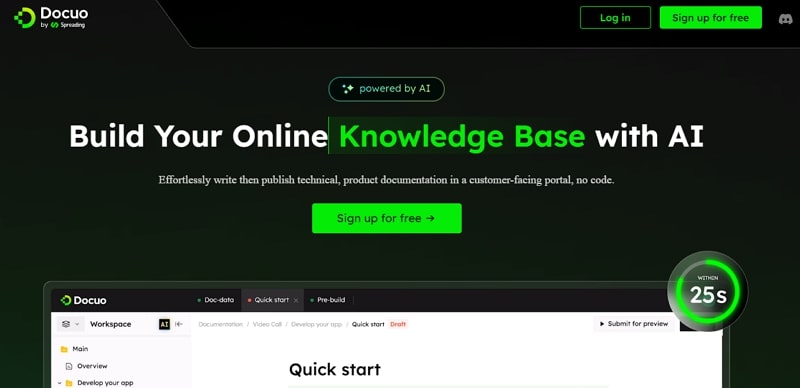When it comes to a company’s success, it all depends on how you share knowledge with your team. Therefore, big companies thrive by transferring explicit knowledge that can be shared as a document. This article will also discuss benefits, examples, and how to manage information for your business’s growth.
What is Explicit Knowledge?
Simply put, explicit knowledge is the information that can be shared, documented, and stored within the company’s knowledge base. This knowledge is an expressive form of information that is easy to understand for the employees and passed on to others. This knowledge can be digitized into reports, documentation, manuals, and databases.
So, what is explicit knowledge again? It is the type of information that makes it easy to understand, store, and communicate information to others in the company. Furthermore, this knowledge enhances overall learning and establishes a foundation for thorough knowledge sharing. Other people in the company can also review and access this information to improve their workspace.
What are the Benefits of Explicit Knowledge?
Explicit knowledge helps employees to share valuable knowledge with their co-workers in an organization. Therefore, transferring essential knowledge can benefit the company and its employees in doing their job more effectively. We have provided you with some of the benefits of explicit knowledge and how it can benefit the company.
- Enhance Decision-Making Process: Employees can learn from the past experiences of other employees through explicit knowledge stored in the company. Also, it helps them make better decisions and resolve issues within minutes.
- Improve Company’s Agility: The company’s agility increases by sharing explicit information with others. Accessing information quickly enhances communication between employees. Other than that, employees can utilize this information and push through hurdles and challenging tasks.
- Reduce Errors and Mistakes: There should be no room for errors as employees can access the company’s procedures and policies. Knowing what task needs to be done and how to reduce the mistakes and streamline documentation operations.
- Prevent Any Knowledge Loss: The most significant benefit of explicit knowledge is that it safely stores the data and prevents the risk of losing the knowledge. Hereby, safely capturing the information allows everyone in the company to learn from it.
Explicit vs. Tacit Knowledge
The significant differences in explicit vs. tacit knowledge are provided in the table below. This table will give the necessary differences between explicit and tacit knowledge. It is so that every employee knows what information will be most helpful in various situations.
| Metrics | Explicit Knowledge | Tacit Knowledge |
|---|---|---|
| Definition | Explicit knowledge is defined as the information that is quickly recorded into documents. Moreover, this information can be easily articulated and shared with other employees. | Tacit knowledge is knowledge that is difficult to articulate as it is based on techniques, know-how, and processes, and it is acquired through one own experience. |
| Nature of the Knowledge | It is objective, logical, and is based on technical information. | It is entirely subjective knowledge and is based on personal experiences. |
| Codifiability | This knowledge is codified into handbooks, manuals, reports, and codes of conduct. | This information is only recorded as a personal experience, such as insight, intuition, and wisdom. |
| Storage System | The information can be recorded in any physical form, like on a knowledge base or software. | On the other hand, tacit information is subjective and cannot be stored. |
| Easy-to-Understand | Explicit information is much easier to understand as they are recorded with accuracy. | In contrast, tacit information cannot be understood as it is difficult to express and explain to others. |
| Transferability | You can share or transfer explicit information through digital means as they are stored in databases. | This information is more challenging to transfer to other employees as it can be acquired by in-person interactions and analysis. |
| Accessibility | This knowledge is easily accessed through online knowledge bases. | You can observe your seniors or learn through experiments and research. |
5 Examples of Explicit Knowledge
We have looked at the main differences between tacit and explicit knowledge, and we now need to understand what examples of explicit information are. The following explicit knowledge examples can be in any form, depending on the organization’s needs.
1. Employee Handbook
An employee handbook is an explicit knowledge example that stores all the information about the work culture and policies. It provides employees guidance related to the organization’s history, values, and mission in a written form. Furthermore, the employee handbook provides team members with a clear understanding of their duties.
2. Knowledge Bases
The knowledge base is a self-serving library of information that provides employees with knowledge on products, services, and departments. It is a 24/7 accessibility platform that helps give the members a work-centered learning base. Moreover, employees can search documents according to their needs anywhere and anytime.
3. Training Material
The organization designs training materials to teach new employees relevant knowledge and skills. These documents are presented in a presentation format and e-learning modules. Moreover, this explicit knowledge example ensures that everyone receives the same fundamental knowledge and understands their task.
4. Company Code of Conduct
The code of conduct sets a range of expectations within the organization that every employee has to meet through their work and behavior. Codes are like policies that provide explicit knowledge to employees about the company’s policies, principles, and what behavior they expect. Furthermore, it also ensures consistency and professionalism among the employees in the company.
5. Research Report
In any business organization, a research report plays a crucial role in determining the marketing growth of the company. A research report is a structured form of explicit knowledge that provides the company with findings and analytics. It also includes reporting marketing trends, campaign success, and customer behaviors to determine whether their marketing strategies are working.
How to Transfer Tacit and Explicit Knowledge?
As we understand tacit vs. explicit knowledge, we also need to know how we can transfer this knowledge to employees. Knowledge is valuable, and with this information, a company can reach the highest marketing values. Therefore, the following are the four ways to transfer tacit and explicit knowledge in an organization.
1. Explicit-to-Tacit
One of the ways of transferring knowledge is the explicit-to-tacit method. It occurs when an individual leaps into learning new skills on their own accord. Additionally, the employees apply for various courses to improve their skills, knowledge, and communication. Thus, the company provides them with articles and user guides to read and videos to watch to enhance their understanding of a product.
2. Explicit-to-Explicit
The explicit-to-explicit approach combines the existing knowledge with the new information gathered by the employees. It creates a new form of explicit knowledge example that other employees benefit from. Furthermore, digitizing the new information into documentation and sharing it online in a PDF or any other format enhances accessibility.
3. Tacit-to-Explicit
The tacit-to-explicit method, also known as externalization, represents another approach to transferring knowledge. In other words, employees utilize what they already know and encode the information in a way that is easy for others to understand. Additionally, transfer it through product reviews, user guides, and manuals.
4. Tacit-to-Tacit
Tacit-to-tacit method is about exchanging ideas, suggestions, and experiences and then applying the knowledge internally. Furthermore, store this knowledge in the company’s knowledge base through interviews and workshops. This helps employees learn new techniques and unlock their expertise and potential in the workspace.
How to Manage Explicit Knowledge for Business?
Now that you know about explicit knowledge definition and its example, it is time to learn how to manage such knowledge. Therefore, in the following section, we have provided proper planning and explicit knowledge strategies.
1. Create a Centralized Knowledge Base
The first step in managing explicit knowledge for your business is to establish a centralized knowledge base. In this case, store, share, and make your documentation easily accessible to the employees. Furthermore, these documents can include manuals, standard operations, and documents.
2. Encourage Employees to Contribute Knowledge
Everyone needs to contribute and add their knowledge to the documentation process. After all, knowledge management is all about team effort and involving employees in the documentation process. Moreover, you should reward your team for prioritizing sharing knowledge with others.
3. Establish Goals to Capture Knowledge
Business managers must establish specific goals to capture knowledge and transfer it to others. If we compare explicit vs. tacit knowledge, the first one is a lot easier to capture and share than the other. Also, it is essential to point out the exact conditions under which your company loses knowledge. After that, create hypotheses and set short and long-term goals as they’ll provide you with solutions.
4. Choose the Right Software to Create a Knowledge Base
You cannot manage all this information alone, which is why having the right tools to manage your knowledge is essential. Docuo is an excellent knowledge-based creation tool powered by AI tools that produce stellar documentation. Additionally, it organizes documents effortlessly for you to share and store with your team.

5. Use an Analytical Tool to Collect Feedback
To maintain an effective documentation base, you should utilize an analytical tool that evaluates the performance of your documents. The analytical tool produces an in-depth analysis report on the documents by collecting feedback from customers and employees to improve it further.
6. Keep Your Documentation Updated
The last tip is to keep your documentation updated with every new feature, advancement, and tool introduced in the document. Additionally, you should track down your document progress and operate onward from there. Updating a knowledge base requires consistently adding new information or elements; otherwise, it serves no purpose.
Conclusion
In the end, explicit knowledge plays a vital role in a business’s growth as it enhances productivity and development. Additionally, having reliable software like Docuo makes all the difference, as you can utilize its AI-powered tools to manage files. Also, this tool accelerates collaboration within the company, and they work together to create stellar documentation.
Moreover, the document management feature of Docuo keeps track of any changes, maintains previous history, and centralizes documents all in one place. So, press this tool’s “Sign Up” button to get your hands on this excellent knowledge base tool.

Read more:


